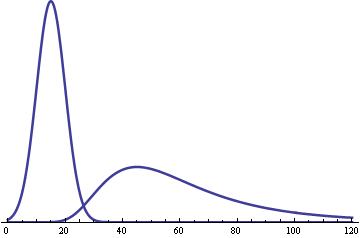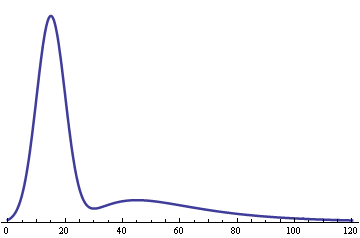This post looks at applying object oriented programming ideas to probability distribution software. It explains the Liskov Substitution Principle and shows how it can keep you from falling into a subtle trap.
One of the big ideas in object-oriented programming is to organize software into units of data and related functions that represent things in your problem domain. These units are called classes. Particular instances of classes are called objects. For example, a business application could have a customer class. Particular customers are represented by customer objects.
The C++ numerical library that we developed at MDACC has classes that represent probability distributions. A probability distribution class contains methods (functions) such as PDF, CDF, Mean, Mode, etc. For example, the NormalDistribution class represents normal distributions. Particular NormalDistribution objects each have their own mean and variance parameters.
Another big idea of object-oriented programming is inheritance, a way to organize classes into a hierarchy. This is where things get more interesting.
Inheritance is commonly described as an “is a” relationship. That explanation is often helpful, but sometimes it can get you into trouble. (Listen to this interview with Robert Martin for an explanation.) Probability distributions illustrate when “is a” should be represented by inheritance and when it should not be.
A beta distribution is a continuous distribution. So is a normal distribution. The BetaDistribution and NormalDistribution classes representing these probability distributions both derive from ContinuousDistribution class. This makes it possible to write generic code that operates on continuous distributions. Later we could pass in a particular type of continuous distribution rather than having to write special code for every kind of continuous distribution.
Now think about a chi square distribution. A chi square distribution with ν degrees of freedom is a gamma distribution with shape ν/2 and scale 2. So in a mathematical sense, a chi square distribution “is a” gamma distribution. But should a class representing a chi square distribution inherit from a class representing a gamma distribution? The surprising answer is “no.” A rule called the “Lyskov Substitution Principle” (LSP) says this is a bad idea.
When a class X inherits from a class Y, we say X is the derived class and Y is the base class. The LSP says code should work without surprises when an instance of a derived class is passed into a function written to receive instances of the base class. Deriving a BetaDistribution class from a ContinuousDistribution class should not lead to any surprises. A function that handles continuous distributions in general should work just fine when you give it a specific distribution such as a beta, normal distribution, etc.
Now suppose we derive our ChiSquareDistribution class from the GammaDistribution class. Suppose also we have a function that expects a GammaDistribution object. What happens if we pass it a ChiSquareDistribution? Maybe the function works with no surprises. If the function calls methods like PDF or CDF there’s no problem. But what if the function calls a SetParameters method specifies the shape and scale of the distribution? Now we have a problem. You can’t set the shape and scale independently for a chi square distribution.
If you try to make this work, you’re going to dig yourself into a hole. The code can’t be intuitive: two people could have reasonable but different expectations for how the code should behave. And attempts to patch the situation are only going to make things worse, introducing awkward dependencies and generally entangling the code. The LSP says don’t go there. From an object oriented programming view point, the gamma and chi square distributions are simply unrelated. Neither derives from the other.
The canonical explanation of the LSP uses squares and rectangles. Geometrically, a square is a special type of rectangle. But should a Square class derive from a Rectangle class? The LSP says no. You can’t set the length and width of a square independently. What should a Square class do when someone tries to set its length and width? Ignore one of them? Which one? Suppose you just use the length input and set the width equal to the length. Now you’ve got a surprise: setting the length changes the width, not something you’d expect of rectangles. Robert Martin does a good job of explaining this example in the interview mentioned above. On the other hand, if a Square class and a Rectangle class both derive from a Shape class, code written to act on Shape objects will work just fine when passed either Square objects or Rectangle objects.
Programmers will argue till they’re blue in the face over whether a Square “is a” Rectangle, or vice versa, or neither. The resolution to the argument is that inheritance does not mean “is a.” The idea of “is a” is often useful when thinking about inheritance, but not always. Of course a square is a rectangle, but that does not mean it’s wise to derive a Square class from a Rectangle class. Inheritance actually has to do with interface contracts. The pioneers of object oriented programming did not use the term “is a” for inheritance. That terminology came later.
So although a chi square distribution is a gamma distribution, a ChiSquareDistribution class should not inherit from a GammaDistribution class, just as a square is a rectangle but a Square class should not inherit from a Rectangle class. On the other hand, chi square and gamma distributions are continuous distribution, and it’s fine for ChiSquareDistribution and GammaDistribution classes to inherit from a ContinuousDistribution class, just as it’s fine for Square and Rectangle classes to derive from a Shape class. The difference is a matter of software interface functionality and not philosophical classification.


